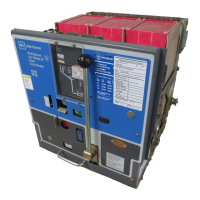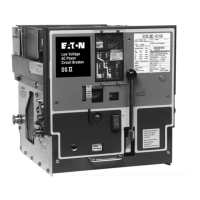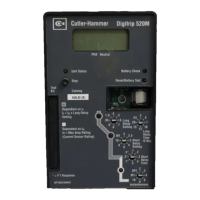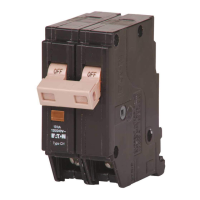1.8. 33-790-11
The trip shaft can be rotated to trip the breaker
in
the fol-
lowing ways:
1.
By hand push on the trip plate. As shown
in
Figure
27, this item has a tab which pushes against a pin on
the trip shaft which applies a direct rotating force
on
the shaft
in
the tripping direction.
2.
By shunt trip device, as shown
in
Figure 23a. The
armature
of
the clapper-type electro magnet pushes
on a lever
on
the trip shaft to rotate it
in
the tripping
direction.
3.
By action
of
the actuator, as shown
in
Figure 24b. A
downward pull by the trip plunger pulls on a lever
from the trip shaft to rotate it
in
the tripping direction.
4.
By action
of
the trip plate
on
the front
of
the breaker
compartment door (providing the breaker is
in
the
connected position.) A flap on the breaker compart-
ment hinged door, operating through a sliding link
and lever fastened to the cradle move the compart-
ment trip lever extending from the bottom
of
the dra-
wout unit. Refer to Figures 25 and 26.
5.
An undervoltage trip device is available as an acces-
sory, and will directly operate the trip shaft. This is
shown
in
Figures 67 & 68, and its operation is cov-
ered
in
Section 8.7.1.
6.
Blown Limiter Indicator. See Fig. 80.
5.1.6.1 Miscellaneous Details
Figure 26 shows a bottom view
of
the breaker drawout
unit. Visible
in
this picture are details as follows:
1.
The Interference Interlocks
These are Z-shaped brackets which prevent circuit
breakers with insufficient interrupting ratings (or mis-
matching disconnects) from being inserted into wrong
compartments.
This compartment
Will accept these
breakers
DS-206 DS-206
DS-206S DS-206S, DS-416,
DS-416S, DS-420
DS-416 DS-416, DS-416S,
DS-420
DS-416S DS-416S, DS-420
DS-420 DS-416S, DS-420
DSL-206 DSL-206
DSL-416 DSL-416
Effective October 1998
DRAWOUT
UNIT
POSITION
INl)!CATOfi
INTERLOCK
SCREW
FOR
CLOSE
INTERLOCK
Page 27
ANTI-BOUNCE
LATCH
Fig. 25 DS-632 Breaker with Front Panel Removed
(391063)
2.
Ground Contact
This contact engages a corresponding contact
on
the
compartment floor and provides positive grounding
of
the
breaker frame.
3.
Motor Cut-Off Switch
On power-operated breakers this switch disconnects the
motor when the charging
of
the closing springs is com-
plete. It is operated by motor cut-off switch lever shown
in
Figures 13 and
15,
which also operates the spring charge
indicator.
4.
Seismic Positioner
Seismic Positioner increases the rigidity
of
the breaker to
withstand sideways forces due to vibrations
on
earth-
quake condition. As shown
in
Figure 26b, it is mounted
on
the top rear
of
the breaker pole unit frame and
engages with a spring loaded counterpart
in
the enclo-
sure.
Courtesy of NationalSwitchgear.com

